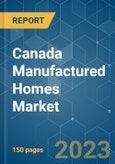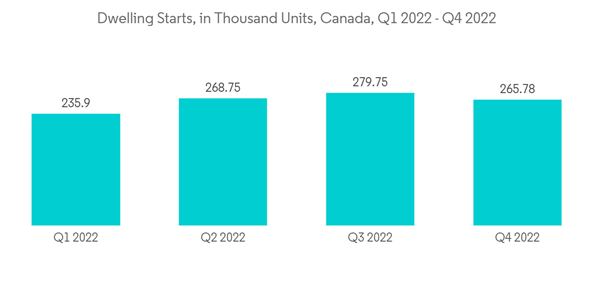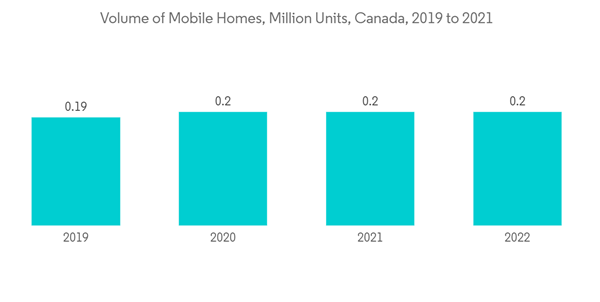Key Highlights
- The COVID-19 epidemic has also caused an urgent demand for solutions for homes, schools, and healthcare facilities. As a result, throughout the anticipated period, the aforementioned variables are anticipated to fuel the expansion of the manufactured home market in Canada.
- In towns across Canada, manufactured housing is becoming more and more popular as a practical solution for providing livable and cheap accommodation. This style of housing, also known as modular or pre-fabricated dwellings, is created in factory-controlled environments before being transported to the construction site, either in portions or as a whole, for installation and completion. One of the benefits of the manufactured home is cost efficiency. Construction may be done year-round in a climate-controlled setting without the disruptions and added expenses caused by inclement weather and temperature swings.
- The effective use of building materials, ease of labor scheduling, and ability to buy supplies in bulk are all made possible by computer-aided design and manufacture, which also permits customization of the final product. Constructing different parts of the home concurrently allows for quicker building timelines. Manufacturing facilities tend to be more secure than building sites, which reduces material losses and theft. The air-sealing process and overall quality control can be enhanced by using precise production tools and procedures. In addition, manufactured housing may be quickly and easily installed in isolated rural places, ecologically sensitive locations, or on small urban lots.
- Local companies, people, and organizations across Canada are at the center of initiatives to build more affordable housing in their neighborhoods. To assist the development of new affordable housing options without federal subsidy, the Affordable Housing Centre collaborates with for-profit and non-profit developers.
Canada Manufactured Homes Market Trends
The Rapid Rise of Affordable Manufacturing Housing Market in Canada
The Rapid Homes Initiative (RHI) was started by the Canadian government through the Canadian Mortgage Housing Corporation (CMHC) to help needy Canadians who urgently need housing. In the immediate aftermath of COVID-19, the initial round of the RHI's investment, which went entirely toward transportable structures, was about USD 1 billion and it was used right away. In actuality, the RHI went above and beyond its original goal of constructing 3,000 additional affordable housing units, ultimately helping to fund the building of more than 4,700 homes across Canada. A second round of funding for the RHI which totaled USD 1.5 billion, was given in 2021 to be used for the development of new multifamily housing. Similar to the first round, this extra funding enabled the RHI to build more than 4,500 new affordable housing units, surpassing its initial goal. In all, more than 5,400 new housing units are anticipated to be built across Canada.Following these construction activities, another significant announcement was made in 2021. In a joint effort with the CMHC, the two biggest banks on the continent, Scotiabank and Bank of Montreal, pledged to invest a combined USD 22 billion in new affordable housing across Canada over the next ten years.
The modular-focused RHI is receiving as much of these pledged money as it can, and MBI is collaborating closely with the CHMC to do so as it has from the beginning. The RHI itself is presently drafting the application rules for its anticipated third round of financing. The requirement for accessible and cheap housing across the nation might be significantly reduced with the help of flexible construction.
People Consider Manufactured Homes to be an Excellent Option for Current Canada's Housing Issue
There is a housing issue in Canada and the country needs an increasing number of homes, but there aren't enough workers to create them. Experts predict that some homebuilders and legislators may find prefabricated homes to be the solution to this issue. A type of home known as manufactured housing is one in which the building components are constructed in a factory rather than on-site. The building can be constructed more accurately with reduced energy expenses and construction can be done quickly by producing in a factory. Additionally, not being built on-site reduces labor expenses as well.As opposed to prefabricated homes, which are created before being transported, many homes in Canada are traditionally built utilizing the "stick building" method. Stick construction denotes the on-site assembly of the components. Because of their housing issue, it's amusing to see Canadians reverting back to manufactured homes. Through social media platforms like Instagram, modular housing is getting a lot of attention and is growing in popularity. Although one hasn't precisely taken over the market just yet, there have been more businesses producing prefabricated homes as a result of rising demand.
Canada Manufactured Homes Market Competitor Analysis
The environment of the Manufactured Housing sector is fragmented, with a mix of international, regional, and local businesses. Local players in the area are well recognized for their quick delivery of manufactured homes. Alta-Fab Structures, ATCO, Champion Home Builders, NRB Modular Solution, Stack Modular, Guildcrest Homes, Legendary Homes, and Northern Comfort Modular Homes are among the nation's top competitors.Additional Benefits:
- The market estimate (ME) sheet in Excel format
- 3 months of analyst support
Table of Contents
Companies Mentioned (Partial List)
A selection of companies mentioned in this report includes, but is not limited to:
- Alta-Fab Structures
- ATCO
- Champion Home Builders
- NRB Modular Solution
- Stack Modular
- Guildcrest Homes
- Legendary Homes
- Northern Comfort Modular Homes
- Comfort Homes
- Smart Modular Canada
- Quality Homes
- Ranch Homes
- Bay Builders
- Royal Homes
- Linwood Homes
- Canada Modular
- KB Prefab










